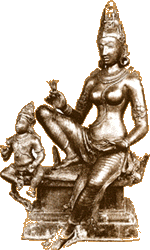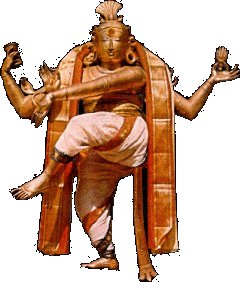

 |
 |
 |
500 B.C - 10 A.D Bharatha Natyam is a composite art, whose message is not merely to the senses, but to the soul of the dancer and of the perceiver. Due to this, one could comprehend that Bharatha Natyam is an art that conveys spiritual expression. This dance form cannot be adequately danced by anyone without reverence for technique and for spiritual life.  It is an art that lifts one from temporal to eternal values.
The intimate association of dance with religion and as a ritual, a form of worship in
the temples is well established. The institution of the Devadasis, servants of the
God, contributed in perpetuating and preserving the art. In ancient times, the
system of dedicating young dancers to the temples as devadasis seems to have
prevailed.
It is an art that lifts one from temporal to eternal values.
The intimate association of dance with religion and as a ritual, a form of worship in
the temples is well established. The institution of the Devadasis, servants of the
God, contributed in perpetuating and preserving the art. In ancient times, the
system of dedicating young dancers to the temples as devadasis seems to have
prevailed.Dance has special mention in two important Tamil works Silappadikaram and Manimekhalai of the Sangam age ( 500 B.C - 500 A.D ). The sacred texts of the Shaivagamas prescribed the mode of worship and referred to the consecration of dancing girls in the service of the gods. The temples were not only places of communication between man and God, but also strongholds of the Arts. In the beautiful Nata-Mandapas (dance-halls) of the magnificient temples, the devadasis used to perform ritual dances as votive offerings to the presiding Dieties. The present BharathaNatyam can be traced back to this form. It has been established from the scluptural evidence, that of technique of movement which this style follows can be traced back to the 5th century, the position common to the classical dance ( margi style ) was the ardhamandali with the out - turned knees. By the 10th century A.D. , this basic position was common to dance styles from Orissa to Gujarat and from Khajuraho to Trivandrum. From about the 10th century A.D. in sculptures of dance, we find that basic position of the lower limbs is common to relics in particularly every part of India. 
10 A.D - 14 A.D After the 10th century, Bharathanatyam seems to have developed chiefly in the South and gradually came to be restricted to what is now known as Tamil Nadu. From  chronicles we learn that the Chola and the Pallava kings were
great patrons of the arts. Raja Raja Chola not only maintained
dancers in the Temples in his kigdom, but was a very great
connoisseur of music and dance. The tradition of the
Natyasastra appears to have been widesprread. The accuracy
with which the artists of the Brihadeeswara temple in Thanjavur
have illustrated the karanas of the fourth chapter of the
Natyasastra is adequate proof of their understanding of the
laws of the dance movement.
chronicles we learn that the Chola and the Pallava kings were
great patrons of the arts. Raja Raja Chola not only maintained
dancers in the Temples in his kigdom, but was a very great
connoisseur of music and dance. The tradition of the
Natyasastra appears to have been widesprread. The accuracy
with which the artists of the Brihadeeswara temple in Thanjavur
have illustrated the karanas of the fourth chapter of the
Natyasastra is adequate proof of their understanding of the
laws of the dance movement.
Along with the building of the imposing temples in the South under The Pallava and Chola rulers ( 4th to 12th A.D), the arts of music and dance received a great fillip. The tradition was kept alive by rulers , specifically, the Pandya, Nayak, and the Maratha, till the end of the nineteenth century. It was the institution of the great dance teachers known as Nattuvanars who preserved the ancient dance art from generation to generation. 
14 A.D - 18 A.D About the 14th century A.D. we find that technical illustrations of dance movements were made in the Sarangapani temple at Kumbakonam and in the four magnificent gopurams of the Nataraja Temple in Chidambaram. Illustrations of the charis and the karanas are found in temples of Gangaikonda, Cholapuram, Kumbakonam, Madurai and Kancheepuram. The sculptural evidence can be supplemented amply by the Sastras, textual criticisms, historical chronicles and creative literature. Between the 14th and 17th centuries, there was much repetition of dance poses already sclupted in the three main temples mentioned above. From the creative literature in Tamil, Telugu and Kanada, one can easily conclude that the dance was a vigorous and living art.
During the Maratha rule ( AD 1674 - 1854 ) over Thanjavur the art of Bharatha
Natyam received considerable fillip. King Shahaji ( 1684 - 1711 ) wrote nearly five
hundred padams ( short poetic compositions ). These marathi padams are found in
the form of palm-leaf manuscripts in the Telugu script. These manuscripts are
preserved in the Saraswati Mahal Library at Thanjavur. King Tulaja II ( 1763 - 87 )
wrote the Sangitasamrita which deals with adavus, the basic dance steps, is a
landmark in the dance literature. During the reign of King Sarfoji II, the tradition of
bharathanatyam received its definite shape from the Thanjavur Quartet Chinayya,
Ponnayya, Vadivelu and Sivanandam, the four brothers who were disciples of the
composer Muthuswami Dikshitar, one of the trinity of Carnatic music.
18A.D - 19A.D Between the period 1800 to 1920, bharatha natyam as a performing art took a back seat. The performances used to extensively take place during Vasanthotsavams ( temple festivals)
In 1926, a young lawyer, E. Krishna Iyer played an important role in the ervival of
Bharatha Natyam. He used to perform on various platforms by doning the attire of
female bharatha natyam dancer to remove the stigma attached to the art. In 1927, E.
Krishna Iyer organised the first All India Music Conference at Madras, during the
session of the Indian National Congress and as an offshoot of the conference, the
Music Academy was born in 1928. For a decade he worked as one of its secretaries.
National spirit coupled with the freedom movement was responsible for the increase
in the revival of performances at various places. Some of the exponents in those
days were Pandanallur Jayalakshmi and Jeevaratnam, Smt. Rukhmini Devi Arundale,
disciples of Pandanallur Guru Meenakshisundaram Pillai, Ram Gopal, Mrinalini
Sarabhai and others. Since then, till now, a host of legendary figures have
contributed to the centuries old art - Bharatha natyam.
|